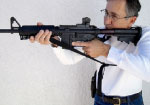By: R. S. Eden
Since the addition of OC (Oleoresin Capsicum) products to the law enforcement arsenal of non-lethal products there has been much controversy over what effect the product will have on the police service dog.
Initially these pepper based products were produced as an effective protection for postal workers to use on dogs encountered on their routes. A 30% solution is even promoted and sold in wilderness areas as a bear repellent. Practical experience using the product on dogs in street situations proved the effectiveness of the OC products against the typical canine. Manufacturers’ information, along with the effectiveness of the product on the street against vicious dogs that were encountered by postal workers, meter readers, police officers and other public service people seemed to reinforce the notion that the product would also be effective against police service dogs.
This is not necessarily so.
Initially, my own observations led me to believe that police service dogs could not be deployed in an OC environment. My advice was always to use CS products when there would be a need to deploy the dog into a gas environment.
The Calgary City Police Service subsequently did some testing, deploying dogs into some heavy OC environments using various concentrations of the products. Their results indicated that police dogs introduced into an OC environment could in fact work in that environment.
At the 1994 International Police K9 Conference held in Las Vegas, Nevada, we subjected service dogs to a number of scenarios involving OC environments. Using ferret rounds, we saturated an enclosed room with 10% OC product. A K9 was then deployed into the room and observations were made as to his performance. The dog had no difficulty working a quarry on a sleeve and exhibited no outward signs of difficulty in breathing or any sensitivity to the environment. The dog was then directed to search the room for his favorite retrieval toy, a ball, which had been thrown into the room. Again, the dog worked in the OC showing no outward signs of discomfort. This experiment proved that a police K9 can work in situations where OC has been deployed in confined areas, contrary to past opinion.
A third situation was set up using a 5% OC spray canister. This test was to find out how a dog would react should he be sprayed with OC by a suspect during an apprehension. A canister that delivered a broad spray as opposed to a streamer delivery system was used as the contact would be close and it was felt that a stream delivery would be harsh on the dog if there was a direct hit in the eyes.
The dog was sent to apprehend the suspect and once on the bite was sprayed extensively in the face. This dog was a fresh K9, and had never previously been exposed to any OC product. Initially the dog had a good bite, but upon the first hit of spray the dog went into even a more intense fight with the suspect. Nearly half the canister was delivered before the dog was called off. The dog had received numerous shots in the eyes and nose areas during the apprehension and still the dog chose to stay in the fight. It was obvious that the dog was under a lot of discomfort. His eyes were shut tightly, but his bite never did relax. Once the dog was called off the bite the suspect was then directed to flee and hide in preparation for an area search. It should be noted that during the experiment the jute sleeve cover on the protective arm guard had been soaked through with OC. The decoy maintained the use of this same sleeve during the second phase of this particular test.
While waiting for the decoy to run into the search area and hide, the dog was noted tobe quite uncomfortable. He rubbed his face in the dirt in an attempt to remove the irritant and it was apparent that he was feeling discomfort similar to that which a human victim of OC would feel.
It should also be noted that if a dog is hit with a heavy burst of OC prior to making physical contact with the decoy, that it could momentarily disorient the dog as he is still targeting the suspect and has not actually made contact. Once contact has been made however, the dog seems to go into fight drive. Even though he cannot see what is happening, he has no need to locate the suspect and his instincts in this case seem to kick him further into fight drive.
There have in the past been questions raised as to whether a dog that has been sprayed would suffer any side effects such as a loss of olfactory abilities. This test was to see if the dog, once off the bite would effectively shut down and not be interested in searching for the suspect. If he did attempt to search for the suspect, would he still be able to work through the heavy OC contaminate that was in his nasal area.
After about a 90 second delay, with the dog still showing a lot of discomfort, the officer released his dog to search the desert for the suspect. As soon as the dog was directed to search, even though he was obviously in discomfort he started to field search as directed. He immediately began casting for the suspect and in short order it was apparent that he had downwinded his quarry. Soon he was running that familiar vectored pattern as he narrowed down the tunnel of scent and finally made contact with the decoy. He took on the decoy with just as much vigor as he had during his initial contact prior to being sprayed with the OC product and showed no visible indications of weakening in his drive or tenacity. Even when biting on a sleeve that was soaked with OC, the dog made contact and held fast.
During the search, the dog worked the scent cone beautifully. There was no indication of his ability to work being hampered in any way by the effects of the OC that he was saturated with. By all our observations the dog worked the situation as he would any normal suspect search.
With the ever increasing number of the criminal element that we now deal with who carry OC type products as offensive weapons, I would highly recommend that you introduce your dog to various situations involving OC products. Do the introduction in phases, allowing the dog to work in OC environments first, and then introducing direct sprays. Your dog can learn to work through these situations.
I recommend that you introduce these situations in a training environment under proper veterinary supervision. All the tests that we conducted in the above mentioned situations were done with the direct supervision of Sterling Johnson of the Simi Valley Police K9 Unit who is also the director of the emergency trauma care program for the conference.
The dogs will work the same way under 10% or 5% OC solutions. Solution concentrations do not affect the intensity of incapacitation but do affect how long the recovery time is for the victim. For our purposes, the use of 5% was more than sufficient to test our concerns and with a quick flushing of cold water over the dogs face, he was back to normal within a 20 minute time period. Of special note, we have seen no long term negative effects realized from the deployment and training of dogs in OC environments.
Hopefully this article will help to dispel concerns about the use of OC with K9 teams. Yes, dogs can be deployed in OC environments very effectively. However, do not deploy any dog into any type of chemical environment, be it OC, CN, or CS without first practicing and experimenting in training situations first. While it is apparent that dogs can work in these circumstances, this will not necessarily hold true for all dogs. There will be some dogs that will not be able to handle chemical environments, and it would be wise to discover which elements, if any, your dog is sensitive to before he needs to confront it in real life.
Note: More advanced information on this subject during sessions instructed at the International Police K9 Conferences held annually in various locations throughout North America.
Featured Author:
Eden Consulting Group

Bob Eden has been a police officer since 1981 working with the Delta Police Department in British Columbia, Canada. Initially assigned to patrol and then traffic section, became a member of the dog section in 1983. He is the author of two books, “Dog Training For Law Enforcement” and “K9 Officers Manual” and has been involved in the development of a number of video productions for law enforcement K9 training. In 1988 Bob was appointed to the B.C. Police Commission’s committee to create minimum police dog training standards for law enforcement agencies in the province of British Columbia.
He was also appointed by the World Police & Fire Games Committee of California to coordinate the competition site for the World Police & Fire Games Police Dog Championships, held in Vancouver, BC in 1989. In 1991 he created and developed the International Police K9 Conference in an attempt to bring a professional training seminar to officers which was not politically oriented or specific to any particular style of training.
Visit the Eden Consulting Group website.
More articles from this author:





